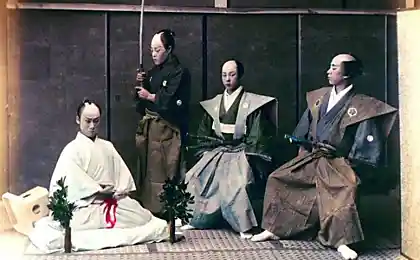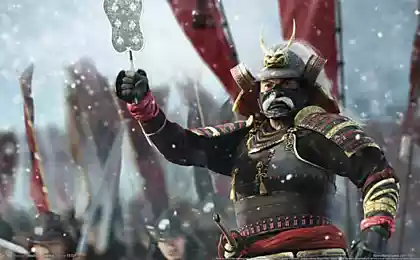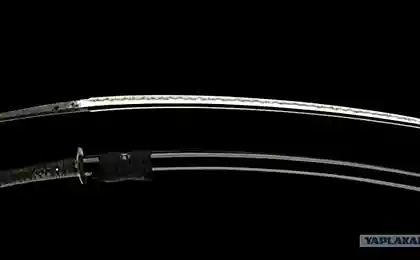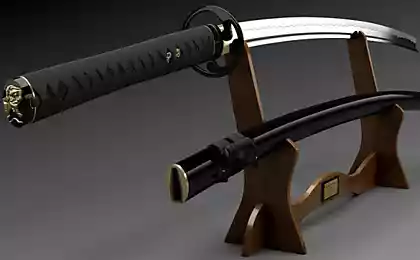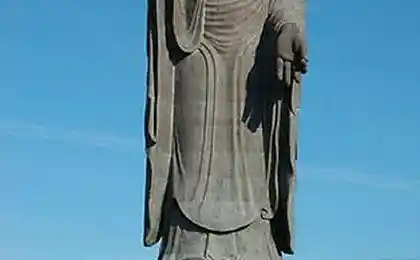601
Samurai — 10 little-known facts
The samurai were legendary warriors and perhaps the most famous class of Japan. They were noble men, fighting against the evil (and against each other) with swords and frightening armor, and followed a strict moral code that governed their entire life.
In fact, the popular legends tell of the samurai is not all. For example:
1. Women samurai
The word "samurai" is traditionally applied only to men. Japanese bushi class to which they belonged, made it possible to teach martial arts and women — such women were called Onna-bugei and participated in wars alongside men. Their weapons usually were naginata — a spear taller than a man with a blade resembling a long curved sword. This weapon compared to the rest was relatively easy and quite efficient.
Historical texts suggest that female warriors among all Japan women's noble origin was not enough — traditionally a Japanese noblewoman was content with the role of Housewives. However, recent studies show that women participated in combat much more often than written in the history books. For example, there was DNA testing of the remains of members of one major battle, and it was found that 35 out of 105 were owned by women.
2. Armor
The most unusual attribute of the samurai is probably their weird but beautiful and ornate armor. Unlike the armor of the European knights, samurai armor was designed primarily for mobility.
Good armor had to be strong, but is flexible enough to allow the owner to move freely on the battlefield. It was a plate of leather or of metal, varnished, carefully adjusted to each other with leather or silk cords. Hands were protected by a massive rectangular shields, and in place of the elbow remained in the lumen. The right hand is often left without protection for maximum freedom of movement.
The strangest part of armor is the helmet of Kabuto: bowl made of chained together metal plates, while the face and brow were protected by armor that is tied in a circle for the head and under the helmet. The most popular design was a helmet, similar to the famous Darth Vader helmet — such headwear could protect the wearer from swords and arrows from all sides.
Also, many helmets were decorations and attach the separate pieces, including a mustachioed demonic Mengu mask, protect face and frightening the enemy. To ensure softness under a helmet used leather handkerchief.
Although samurai armor over time has undergone significant changes in appearance to the untrained observer, has generally remained the same. Actually, the samurai armor was so effective that the US army took over the design of their armor.
3. Homosexuality
The samurai were uninhibited when it came to sexual relations. Like many other culture warriors, for example, the Spartans, the samurai not only believed same-sex relations are normal, but also actively encouraged them. The sexual relationship arose, usually between young students and a teacher, who trained them — this practice was known as wakashudo ("way of youth") and was practiced by almost all representatives of the bushi class.
Although wakashudo was considered one of the fundamental aspects of the way of the samurai, history has kept this little information — for example, in mass pop culture, this fact is almost never advertised.
4. Western samurai
Readers who have seen the movie "the Last samurai", you know that under special circumstances, non-Japanese could fight alongside the samurai, or even to become one. It was a special honor, including the receipt of samurai weapons and a new Japanese name. To give her could only special leaders like the daimyo (lords-landowners) or the shogun (warlord).
The famous four Western men who received the title of the samurai: adventurer William Adams, his partner Jan van Josten Lodenstein, Navy officer Eugene the Bread and arms dealer Edward Schnell. Adams was the most wealthy and influential man of all the four he became adviser to the shogun.
5. The number
Many people think that the samurai were few elite troops like a modern Russian special forces or a small, strictly defined noble caste. However, virtually all social class the bushi consisted of a samurai. Originally, the word "samurai" means "those who frequents the nobility." Over time, the meaning changed and became associated with the representatives of the bushi class secondary and tertiary level, in particular with the soldiers.
This means that these warriors were quite a lot. At the peak of its prosperity to 10% of the population of Japan belonged to the samurai. So, at least half of the current residents of Japan in the blood of the samurai.
6. Fashion
Samurai can be called the rock stars of their time: their clothing style strongly influenced by the fashion of the era. However, with the exception of special occasions, the samurai in daily life dressed modestly. Although their everyday costume was challenging, every aspect has been developed in accordance with the needs of the soldiers.
The suit was supposed to provide the speed and freedom of movement. Usual outfit consisted of pants hakama and kimono or hitatare — bisexual vest, we apply on the shoulders. The usual part of the costume was the weapon, and hitatare could be instantly relieved in case of attack. Kimono was made of silk, which provided both beautiful appearance and coolness. As footwear used in wooden shoes or sandals.
The most common hairstyle was a bun. With the exception of Buddhist monks, who shaved their heads, people of all classes wore a beam for hundreds of years. The habit of combining the beam of the hair with a partially shaved head may have developed out of necessity — with a shaved forehead was easier to wear a helmet.
7. Weapons
The samurai used various weapons. The original weapon was the sword called takuto — thin a smaller version of the straight swords later used by medieval European knights. With the improvement of arms samurai gradually switched to curved swords, which eventually turned into a katana. Katana, perhaps, be called the most famous variant of the sword in the world, and certainly the most iconic weapon of the samurai.
The samurai code of Bushido dictated that a samurai is in his sword, and it elevated her to the rank of the most important weapons. Usually the katana was used in tandem with Dyce, shortened up the master sword, the former a status symbol — Dyce had a right to wear only the samurai.
However, swords were not the only weapons. Not less frequently used Yumi or Luke, because, ultimately, personal bravery on the battlefield was valued less than tactics and planning. When in the XVI century appeared the powder, the samurai abandoned bows in favor of firearms and cannons. Preference Tanegashima — flint guns, popular among samurai of the Edo period and their servants.
8. Education
Members of the samurai class were far more than just soldiers — most of them received an excellent education. At that time, could read very few Europeans, but the level of literacy among the samurai was extremely high, they also studied mathematics.
Bushido dictated that a samurai should strive for self-improvement in a variety of ways, including those not related to martial arts. That's why the samurai had a considerable influence on the culture: they wrote poems, paintings in monochrome ink and were experts in the tea ceremony — it was a regular aspect of their culture. They also studied subjects such as calligraphy, literature and flowers.
9. Physical characteristics
Impressive armor and weapons of the samurai were often forced to seem giants, and that is how they are portrayed in modern pop culture. However, this is far from the truth: the majority of samurai were stunted — so, samurai XVI-th century had a fragile slim body and the height from 160 to 165 cm For comparison — the growth of European knights of the same period ranged from 180 to 196-ti see
Moreover, the noble samurai may not have been so full-blooded, as they would like. Compared to the average Japanese, their skin was noticeably lighter and had more hair. Their profile, namely the shape of the nose is also markedly resembled the European. Ironically, it may indicate that the samurai actually came from an ethnic group Aina, which was considered inferior by the Japanese, often becoming targets of discrimination.
10. Suicide
One of the most frightening things known about the Way of the samurai is seppuku — a ritual also known as harakiri. A samurai was supposed to commit suicide if he was not able to follow Bushido or captured. Seppuku could be both voluntary act, and the punishment, but in any case he was seen as a very honorable way to die.
Most people know about the "field" version of the old quick and dirty. It was necessary to pierce his stomach with a short blade and move it from left to right — indeed, a samurai disemboweled himself. Usually he helped perform the ritual of another samurai, who at this moment cut off the first head, because otherwise the warrior would die very slowly and painfully.
However, the full ritual seppuku is a process much more lengthy and complex. It began with a ceremonial bathing, and then the samurai was dressed in white robes and took your favorite food at the end of the meal he had put the blade on the empty plate. After that he wrote the song of the dead — in fact, his last words. When the poem was written, the samurai had to grab the blade by wrapping pre-hand cloth not to be cut, and slit his belly.
Of course, the final part of the ritual had to be present to each sword, which when cutting off the heads wanted to leave a small strip of flesh at the neck so that the head fell forward and remained in the arms of a dead samurai. And if the head is rolled in the direction of casual viewers, that would mean eternal shame.
источник:publy.ru
Source: /users/1080
In fact, the popular legends tell of the samurai is not all. For example:
1. Women samurai
The word "samurai" is traditionally applied only to men. Japanese bushi class to which they belonged, made it possible to teach martial arts and women — such women were called Onna-bugei and participated in wars alongside men. Their weapons usually were naginata — a spear taller than a man with a blade resembling a long curved sword. This weapon compared to the rest was relatively easy and quite efficient.
Historical texts suggest that female warriors among all Japan women's noble origin was not enough — traditionally a Japanese noblewoman was content with the role of Housewives. However, recent studies show that women participated in combat much more often than written in the history books. For example, there was DNA testing of the remains of members of one major battle, and it was found that 35 out of 105 were owned by women.
2. Armor
The most unusual attribute of the samurai is probably their weird but beautiful and ornate armor. Unlike the armor of the European knights, samurai armor was designed primarily for mobility.
Good armor had to be strong, but is flexible enough to allow the owner to move freely on the battlefield. It was a plate of leather or of metal, varnished, carefully adjusted to each other with leather or silk cords. Hands were protected by a massive rectangular shields, and in place of the elbow remained in the lumen. The right hand is often left without protection for maximum freedom of movement.
The strangest part of armor is the helmet of Kabuto: bowl made of chained together metal plates, while the face and brow were protected by armor that is tied in a circle for the head and under the helmet. The most popular design was a helmet, similar to the famous Darth Vader helmet — such headwear could protect the wearer from swords and arrows from all sides.
Also, many helmets were decorations and attach the separate pieces, including a mustachioed demonic Mengu mask, protect face and frightening the enemy. To ensure softness under a helmet used leather handkerchief.
Although samurai armor over time has undergone significant changes in appearance to the untrained observer, has generally remained the same. Actually, the samurai armor was so effective that the US army took over the design of their armor.
3. Homosexuality
The samurai were uninhibited when it came to sexual relations. Like many other culture warriors, for example, the Spartans, the samurai not only believed same-sex relations are normal, but also actively encouraged them. The sexual relationship arose, usually between young students and a teacher, who trained them — this practice was known as wakashudo ("way of youth") and was practiced by almost all representatives of the bushi class.
Although wakashudo was considered one of the fundamental aspects of the way of the samurai, history has kept this little information — for example, in mass pop culture, this fact is almost never advertised.
4. Western samurai
Readers who have seen the movie "the Last samurai", you know that under special circumstances, non-Japanese could fight alongside the samurai, or even to become one. It was a special honor, including the receipt of samurai weapons and a new Japanese name. To give her could only special leaders like the daimyo (lords-landowners) or the shogun (warlord).
The famous four Western men who received the title of the samurai: adventurer William Adams, his partner Jan van Josten Lodenstein, Navy officer Eugene the Bread and arms dealer Edward Schnell. Adams was the most wealthy and influential man of all the four he became adviser to the shogun.
5. The number
Many people think that the samurai were few elite troops like a modern Russian special forces or a small, strictly defined noble caste. However, virtually all social class the bushi consisted of a samurai. Originally, the word "samurai" means "those who frequents the nobility." Over time, the meaning changed and became associated with the representatives of the bushi class secondary and tertiary level, in particular with the soldiers.
This means that these warriors were quite a lot. At the peak of its prosperity to 10% of the population of Japan belonged to the samurai. So, at least half of the current residents of Japan in the blood of the samurai.
6. Fashion
Samurai can be called the rock stars of their time: their clothing style strongly influenced by the fashion of the era. However, with the exception of special occasions, the samurai in daily life dressed modestly. Although their everyday costume was challenging, every aspect has been developed in accordance with the needs of the soldiers.
The suit was supposed to provide the speed and freedom of movement. Usual outfit consisted of pants hakama and kimono or hitatare — bisexual vest, we apply on the shoulders. The usual part of the costume was the weapon, and hitatare could be instantly relieved in case of attack. Kimono was made of silk, which provided both beautiful appearance and coolness. As footwear used in wooden shoes or sandals.
The most common hairstyle was a bun. With the exception of Buddhist monks, who shaved their heads, people of all classes wore a beam for hundreds of years. The habit of combining the beam of the hair with a partially shaved head may have developed out of necessity — with a shaved forehead was easier to wear a helmet.
7. Weapons
The samurai used various weapons. The original weapon was the sword called takuto — thin a smaller version of the straight swords later used by medieval European knights. With the improvement of arms samurai gradually switched to curved swords, which eventually turned into a katana. Katana, perhaps, be called the most famous variant of the sword in the world, and certainly the most iconic weapon of the samurai.
The samurai code of Bushido dictated that a samurai is in his sword, and it elevated her to the rank of the most important weapons. Usually the katana was used in tandem with Dyce, shortened up the master sword, the former a status symbol — Dyce had a right to wear only the samurai.
However, swords were not the only weapons. Not less frequently used Yumi or Luke, because, ultimately, personal bravery on the battlefield was valued less than tactics and planning. When in the XVI century appeared the powder, the samurai abandoned bows in favor of firearms and cannons. Preference Tanegashima — flint guns, popular among samurai of the Edo period and their servants.
8. Education
Members of the samurai class were far more than just soldiers — most of them received an excellent education. At that time, could read very few Europeans, but the level of literacy among the samurai was extremely high, they also studied mathematics.
Bushido dictated that a samurai should strive for self-improvement in a variety of ways, including those not related to martial arts. That's why the samurai had a considerable influence on the culture: they wrote poems, paintings in monochrome ink and were experts in the tea ceremony — it was a regular aspect of their culture. They also studied subjects such as calligraphy, literature and flowers.
9. Physical characteristics
Impressive armor and weapons of the samurai were often forced to seem giants, and that is how they are portrayed in modern pop culture. However, this is far from the truth: the majority of samurai were stunted — so, samurai XVI-th century had a fragile slim body and the height from 160 to 165 cm For comparison — the growth of European knights of the same period ranged from 180 to 196-ti see
Moreover, the noble samurai may not have been so full-blooded, as they would like. Compared to the average Japanese, their skin was noticeably lighter and had more hair. Their profile, namely the shape of the nose is also markedly resembled the European. Ironically, it may indicate that the samurai actually came from an ethnic group Aina, which was considered inferior by the Japanese, often becoming targets of discrimination.
10. Suicide
One of the most frightening things known about the Way of the samurai is seppuku — a ritual also known as harakiri. A samurai was supposed to commit suicide if he was not able to follow Bushido or captured. Seppuku could be both voluntary act, and the punishment, but in any case he was seen as a very honorable way to die.
Most people know about the "field" version of the old quick and dirty. It was necessary to pierce his stomach with a short blade and move it from left to right — indeed, a samurai disemboweled himself. Usually he helped perform the ritual of another samurai, who at this moment cut off the first head, because otherwise the warrior would die very slowly and painfully.
However, the full ritual seppuku is a process much more lengthy and complex. It began with a ceremonial bathing, and then the samurai was dressed in white robes and took your favorite food at the end of the meal he had put the blade on the empty plate. After that he wrote the song of the dead — in fact, his last words. When the poem was written, the samurai had to grab the blade by wrapping pre-hand cloth not to be cut, and slit his belly.
Of course, the final part of the ritual had to be present to each sword, which when cutting off the heads wanted to leave a small strip of flesh at the neck so that the head fell forward and remained in the arms of a dead samurai. And if the head is rolled in the direction of casual viewers, that would mean eternal shame.
источник:publy.ru
Source: /users/1080


